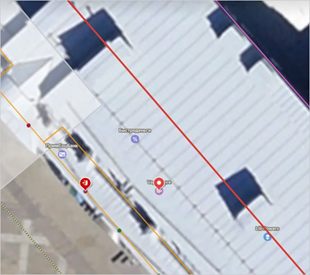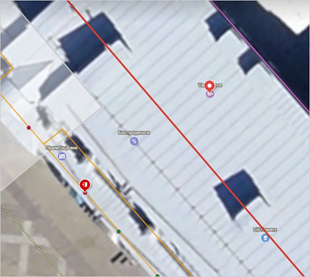3.6.1. Rules for drawing locations (organizations)
Places on the map are represented by more than thirty types of items (for more information, see 3.6.2.1.1. Item type).
In this section:
- 3.6.1.1. Rules and features of drawing places
- 3.6.1.2. Rules for drawing organization placemarks on the map
3.6.1.1. Rules for and features of drawing locations
3.6.1.1.1
-
Make sure that any item you are mapping is not among those that are forbidden to display on the map.
Note
Don't map organizations that don't have an office of their own or
in-home services
(organizations and specialists providing services in residential apartments).
3.6.1.1.2
- Techniques for drawing and editing locations are similar to the techniques for drawing and editing all places on YME. See the following sections:
3.6.1.1.3
-
One item (location) should correspond to one organization, except for:
-
ATMs and payment terminals that belong to the same organization (bank), share the same category, and are located wall to wall.
-
Toll booths on road sections where there are two separate structures operating in each direction (if there's one toll booth for both directions of the road, mark it as one item):


-
Gas stations whose Yandex Business card also includes the LPG Filling Station____ category under Features. In this case, create only one organization with the Gas station category — don't create a separate organization for the natural gas station. If a filling station's organization card in Yandex Busieness contains only the Gas station category under Features, create an organization with the Gas station category and a separate organization with the LPG Filling Station____ category for the natural gas station.

Don't set names of several organizations to the same item. Instead, create a standalone item (place) for each organization.
If an organization offers only one service (for example, ticket sales or home appliances repair), is located in just one room, handles multiple brands, but does not have signs of these brands in its design, draw such an organization as a single item, with the official name indicating general information about the organization's activity.
For example, a service center for home appliances that repairs Electrolux and Birusa products should be crated as one organization with the official name Service center for home appliances repair. Don't include the names of manufacturers in synonyms.
If an organization offers only one service, is located in just one room, handles multiple brands, and has signs of all or some of these brands in its design, create a separate item for each brand that has a sign, with the official name of the item indicating the name of that brand. Create a separate item for all brands that have no sign, with the official item name indicating general information about the organization's activity.
For example, a stand selling membership cards for multiple dance schools (Mama Bear, Papa Bear, Baby Bear, and Goldilocks) that uses Mama Bear and Papa Bear branding. In this case, create separate items with the official names Mama Bear dance school and Papa Bear dance school for the two schools whose branding is present. For the Baby Bear and Goldilocks schools, create just one item with the official name Dance school. Do not add the names Baby Bear dance school and Goldilocks dance school as synonyms.
-
3.6.1.1.4
-
Draw existing (functioning) organizations. If an organization moved to a new address, then you should create a new map item of the
Locations
category. Don't move the old item to the new address; leave a deletion request for it.Only draw closed organizations in cases where they help navigate the area.
For organizations of these types:
- Church
- Cathedral
- Mosque
- Synagogue
- Pagoda
- Overlook
the type of organization doesn't change even if they are closed. For other organizations, including those located in abandoned settlements, upon their closure the subcategory changes to 1.1. Attraction (
1.1.2. Event location, local landmark
), while the status is left asopen
.If it's already public knowledge that a particular item in the
Location
category will be built, then you can draw this item once its construction begins. However, you can only specify a proper name rather than a category name for the building if you have an official document attesting to this name.If a closed organization completely occupied a building that is not currently in use, the building should be assigned the value Abandoned under the Condition attribute (see Cl.4.2.2. Condition).
3.6.1.1.5
- If an organization (
Location
item) only lets in staff and guests (factory workers, hospital patients, and others) within its closed territory, you may draw the followingLocation
type items in the area of the main organization:- Items accessible to everyone whether they're a staff member or a guest.
Location
type child objects that serve the same function as their parent organization (for example: hospital buildings, university departments, company departments) as well as utility structures (infrastructure related to engineering, manufacturing, or transportation).- Tourist attractions and monuments.
- Items from the
Religion
andYard and park infrastructure
categories. If the main organization within the territory belongs to the Religion, Sports, Culture and attractions, or Leisure and travel categories, you can draw any items from theLocations
category within that territory, provided they are accessible to everyone visiting the main organization. For example, restaurants and sports fields located on the premises of a hotel and medical centers in ski resorts.
3.6.1.1.6
-
You can draw temporary items from the
Locations
category (such as dolphinariums, circuses, and so on) on the map if they operate in that location for at least two months. You can also draw seasonal items that operate in a permanent location during the season (such as Christmas tree lots, melon markets, soft drink kiosks, and so on).Don't draw the following on the map:
- Items operating on an irregular basis (for example, pop-up markets, food trucks with no single location, shops that occasionally deliver goods to settlements, and so on). However, such items can be mapped in the "Buildings" layer if they meet the requirements for drawing buildings on the map.
- Organizations that do not have a sign, but are located in premises, providing a single service for multiple brands.
- Natural gas stations located at petrol filling stations whose organization card in Yandex Business also includes the LPG Filling Station__ __ category in addition to the Gas station category under Features.
3.6.1.1.7
-
Culture and attractions → Attractions items related to memorable events can be created only in the most famous places and only if there is no monument or memorial that is already dedicated to this event and drawn on the map as a Monument, sculpture:
-
Historical events that happened more than 40 years ago (for example, the Yuri Gagarin landing site);
-
Significant natural and man-made events/disasters (for example, Tunguska blast site, Titanic wreck site);
-
Battles (for example, Battle of Kulikovo field);
-
Death or execution of famous personalities (such as Mikhail Lermontov's duel site).
Note
One criteria of fame might be if there are more than 100 relevant queries per https://wordstat.yandex.com .
Places that figure in the lives of cultural or historical figures and are marked with monuments, memorial signs, or plaques should be drawn as Culture and attractions → Monument, sculpture items.
You may draw attractions that were destroyed in a fire, collapsed, or demolished if they meet the following criteria:
- It is a well-known attraction that collapsed or was demolished less than 10 years ago
- Its visible traces remain on the site
The item's official name is then set in the following format: [Ruins of + the item's official name].
Examples of renaming objects when they are lost or damaged:
Dubna Ball
→Ruins of Dubna Ball
Yekaterinburg TV Tower
→Ruins of Yekaterinburg TV Tower
-
3.6.1.1.8
- Yandex employees delete (and don't add again) all items of the
Locations
category from buildings with indoor maps, except for the main organizations and the organizations located on floors that have no indoor maps drawn for them.
3.6.1.1.9
- If a shopping center building or part of it was damaged by collapse or fire, all items of the
Places
category located in the damaged part of the building are subject to removal. The building itself is removed from the map only if there is official information that it was demolished.
3.6.1.1.10
- Don't map monuments, memorial plaques, murals, tombs, or similar items located inside buildings (except on the Indoor maps layer).
3.6.1.1.11
- If an organization occupies several non‑neighboring rooms in a building, each with its own infrastructure, create a separate item for each room. In all other cases (different rooms with shared infrastructure or separate infrastructures in adjacent or neighboring rooms), create a single item.
3.6.1.2. Rules for drawing organization placemarks
On the map, draw organization placemarks:
-
In the center of the building or the area it occupies.
-
Where the organization's main sign is.
-
In accordance with its actual location if the organization doesn't have a street sign but its location inside or outside the building is known.
-
Where the entrance to the organization is located if the organization doesn't have a street sign and its location in the building is unknown.
-
In arbitrary order if the organization doesn't have a street sign and its location in the building and the location of its entrance are unknown.
When mapping organizations in buildings, draw the organization placemarks as close to the ideal location as possible. If adjacent placemarks prevent placing the organization placemark in the right place, shift the placemarks of less significant and recognizable organizations to the sides or deeper into the building until there is no overlap anymore. If the placemark of an organization is determined by the position of the sign or entrance, then when moving it deeper into the building, make sure it doesn't cross the middle of the building and remains on the half of the building where its sign or entrance (if there's no sign) is located.
|
Correct |
Incorrect |
|
|
|
The organization priority is as follows:
-
First, draw placemarks of organizations that should be located in the center of the building as close to the ideal location as possible.
-
Then draw placemarks of organizations with street signs as close to the ideal location as possible.
If placemarks of organizations located in the center of the building prevent placing the organization placemark in the right place, shift organizations with street signs from their ideal location until the conflict is resolved. If there's a placemark conflict between different organizations with street signs, resolve it using the rules described in section 3.6.1.2.2.
-
Once you've drawn the placemarks of organizations in the center of the building and those with street signs, draw the placemarks of organizations for which the location in the building is known as close to the ideal location as possible. If there's a placemark conflict with organizations located in the center of the building and those with street signs, shift placemarks organizations with a known location in the building.
-
Then draw the placemarks of organizations for which only the location of their entrances is known as close to the ideal location as possible. Shift these particular organizations to the sides or to the center of the building if there's a placemark conflict with any organizations mentioned above.
-
And finally, randomly draw the placemarks of organizations that have no street signs and with unknown location in the building and entrance location.
3.6.1.2.1
-
Draw the organization's placemark in the center of the building or the area it occupies if:
-
The organization is an architecture landmark used for navigation (such as a temple, attraction, administrative building, cultural center, theater, or museum).
-
The organization has no entrances or signs but occupies an area (such as an observation deck, a courtyard infrastructure item, an impound lot, a race track, a driving area, and so on).
-
This is an umbrella organization for a shopping or business center.
-
The organization belongs to the
Medicine and pharmaceutics
,Education and science
,State and society
,Sport
categories, or to theHotels, housing
subcategory of theLeisure and tourism
category, is the main one in the building (occupying the entire or almost the entire building), and has its own designated territory (for example, separated by fences, walls of neighboring buildings, and so on). Draw the organization placemark approximately in the center of the main (administrative) building. -
There's an Indoor map drawn for the building the organization is located in.
-
The organization is a residential complex (if the residential complex consists of one building, draw the placemark in the center of it; if the residential complex consists of multiple buildings, draw the placemark in the center of the territory).
Note
-
If organization placemarks located in the center of a building overlap with the address point, shift the organization placemarks (not the address point) to the sides to eliminate the overlap.
-
You can also draw a placemark of an organization that doesn't have signs but occupies the entire building in the center of the building as an organization for which the location in the building is known (see section 3.6.1.2.3).
-
3.6.1.2.2
-
Draw the organization's placemark where the organization's main sign is if:
-
The organization has its own sign.
-
It's the only organization in the building and it has one main and several additional signs.
-
The organization occupies part of the territory of a different organization (is its subsidiary or a smaller organization that doesn't belong to the one whose territory it's located on) and isn't an important landmark (if there's no sign, draw its placemark in accordance with its location in the building or its entrance).
-
The organization is located in a movable object like a van, mobile shop, or kiosk (if there's no sign, draw the organization placemark at the window through which the service is provided).
Note
- Don't confuse organizations' signs and sign plates: be sure to place organizations based on their signs only.
An organization's sign plate is a uniformly styled list of organizations located in a building or an area.
Example
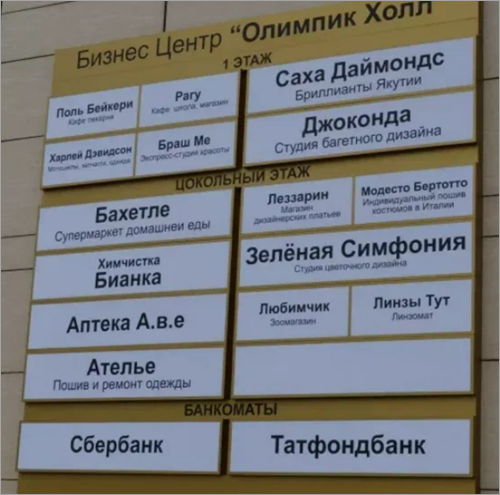
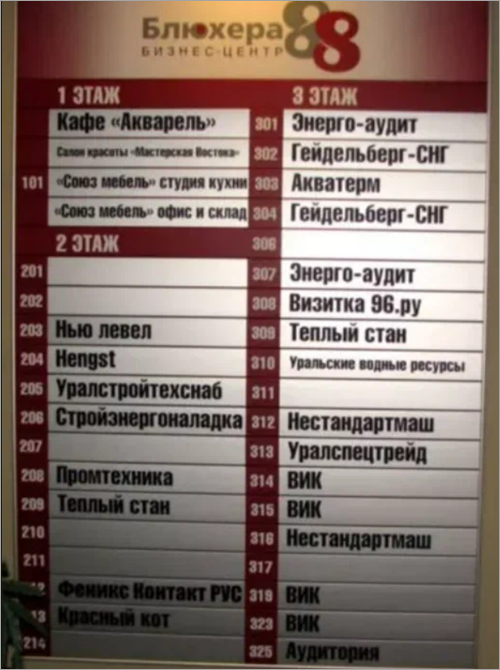
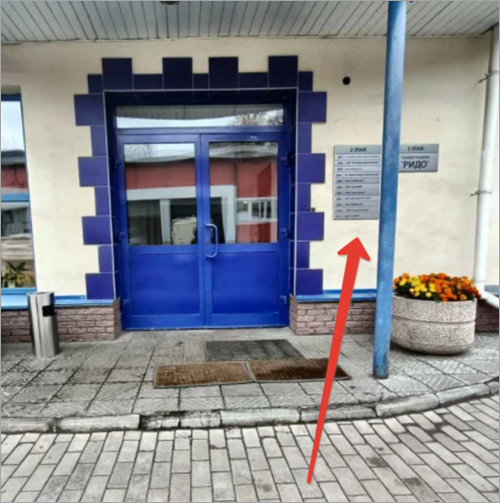
An organization's sign has an original style and is completely mounted onto a building wall, window, or roof. In most cases, it only applies to a particular organization.
Example
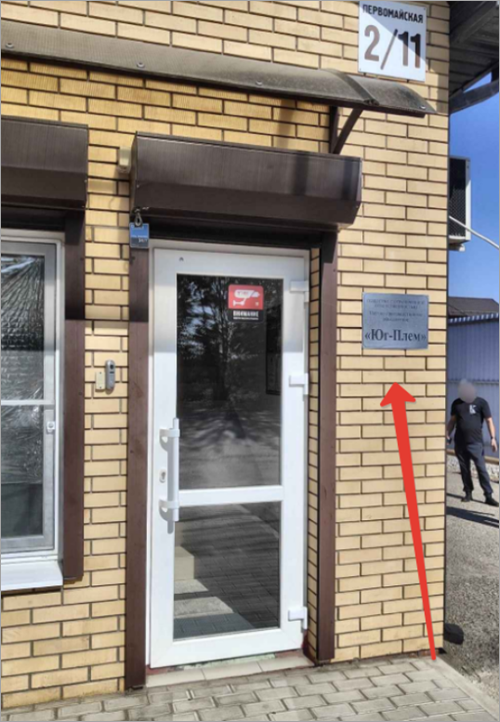
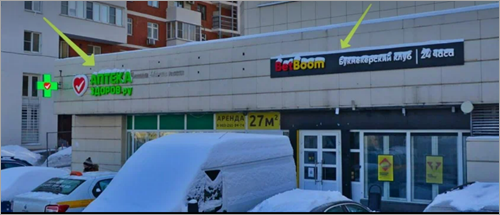
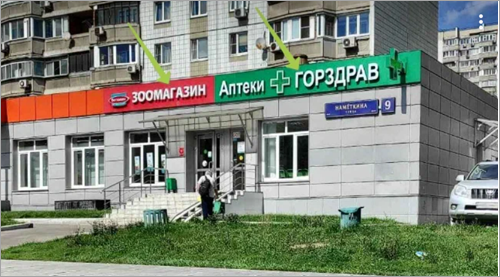
- The entire branded space of the organization, including the building facade or parts of it (if painted in branded colors) is also considered a sign.
A branded space is the facade of an organization that is clearly distinguishable by its signature colors or other decorative elements and has a uniform style.
If the building is branded on all sides, the entire building polygon is regarded as a single sign.
Example
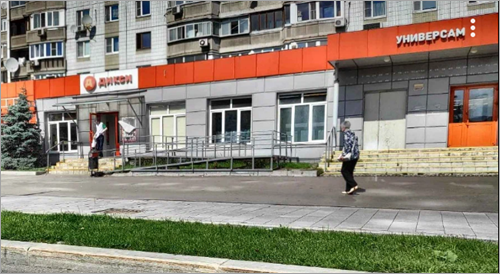
Examples of branded spaces.
Example 1. The facade and windows are uniformly styled and painted in a single, distinct color:
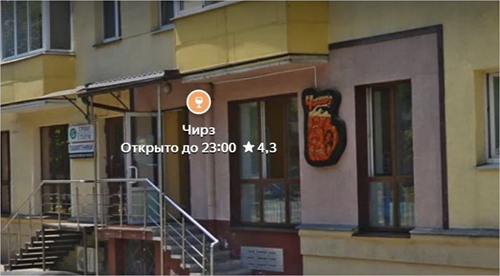
Example 2. The facade is distinguished by columns and wrought iron elements at its sides:
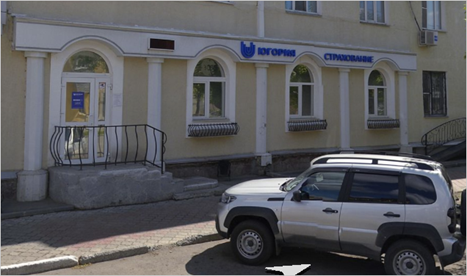
Example 3. At a filing station, the shop and cash desks are styled in corporate colors:

Examples of facades that are not considered to be branded spaces.
Example 1. The facade isn't uniformly styled, with one section being completely gray, while another is decorated with simple brickwork:

Example 2. The store's signature color (gray) is indistinguishable from the building's standard colors:

Example 3: Photos of goods and advertising materials on windows can't be recognized as part of the brand’s design.
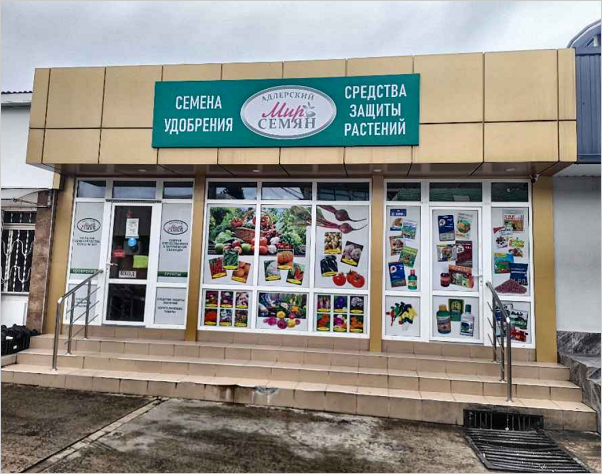
- What isn't considered a sign:
- Letterings and sign plates on the front doors.
- Advertising banners on buildings that point the way to an organization's entrance.
- Banners and sign plates that are mounted on fences, posts, and so on.
Alert
If the sign is placed on the canopy of a building that can't be mapped in Yandex Map Editor, draw the organization's placemark within the footprint of that building.
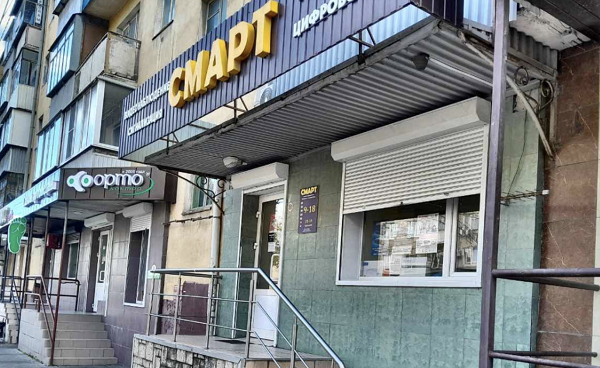
Rules for drawing organization placemarks according to signs:
-
-
The organization placemark should be placed slightly inside the building polygon (not on the line) so it displays correctly on the map. The placemarks of organizations built in the building walls (ATMs, water dispensers, and so on) should also be placed within the building polygons.
-
An organization placemark can't have any overlaps with the building entrance point all the way up to map scale 21.
-
Draw the organization placemark approximately in the center of the sign. If all or at least part of the organization's sign is located above the entrance to this organization, then draw the organization placemark approximately behind the entrance.
-
If an organization has multiple signs, then the largest sign is considered to be the main one (it usually includes the organization's proper name). If all signs are equivalent, the primary one is considered to be the one located at the main entrance of the organization (see section 3.6.1.2.4 for the principles of determining the main entrance to an organization).
-
If there are equivalent signs of the organization on both sides of the entrance to this organization, draw the organization placemark approximately behind the entrance.
-
If a building is branded on all sides, its entire polygon is considered a single sign, and the organization placemark is drawn approximately behind the main entrance to the organization.
-
If an organization has a proper name, but its site is general (for example, the name
DentAll
and the sign is justDentistry
), the sign can be considered as belonging to this organization, provided there's information that confirms this. -
If multiple organizations have signs above the entrance, put the corresponding placemarks with a slight offset to the side of the entrance to avoid conflicts when they are displayed on the map.
If only one organization has a sign (and the others have small sign plates or secondary signs), draw the organization placemark on a line perpendicular to the building polygon and drawn through the entrance point.
-
If the organizations' signs are located above each other, the higher the sign, the closer to the center of the building you should draw the organization placemark.
-
If the small sign of an organization is located right at the entrance door, place the organization placemark at the sign, if possible. Placing it anywhere between the sign and the entrance is also acceptable.
Example
Organization and options for drawing the organization placemark:
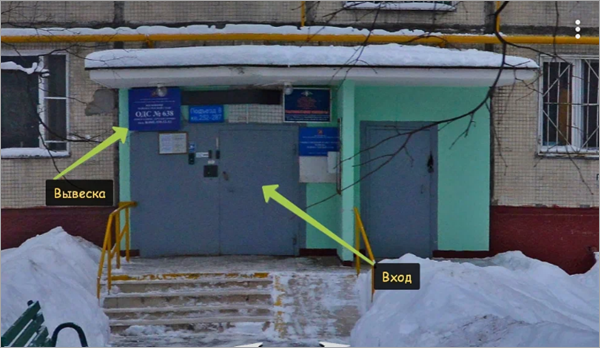


-
-
3.6.1.2.3
-
If an organization has no sign but its location inside or outside the building is known, draw the organization's placemark at its actual location.
For example:
- The organization has no entrances or signs and doesn't occupy an area (monument, landmark, bench, bike parking, recycle bin, and so on). These organizations are placed according to their actual locations; shifting them is forbidden, even when there's a placemark conflict.
- The organization doesn't have a sign or can be identified by small information plates, sidewalk signboards, or stands (for example, engineering infrastructure organizations: pumping station, transformer substation, and so on).
- The organization doesn't have a sign, and visitors enter it from the building's corridor, which can be accessed directly from the street.
3.6.1.2.4
-
If an organization doesn't have a sign and its location inside the building is unknown, draw its placemark at the entrance to the organization.
If there are no conflicts, draw the organization placemark behind the entrance to this organization. When viewed at a scale of 21, the image of the entrance should be within the projection of the organization's icon size on the edge of the building.
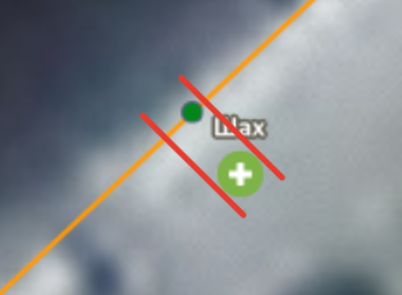
If an organization doesn't have a sign and visitors enter it directly from the street, it's also included in this category (even if the location of the organization in the building is known).
If an organization has several entrances, draw the organization placemark at the main entrance. Determine the main entrance by the size of the door (one door is larger than the other), by the exit to the main street, by the fact that the entrance leads to a larger number of organizations, and by other factors.
3.6.1.2.5
- If an organization doesn't have a sign and both its location inside the building and the location of its entrance are unknown, draw its placemark anywhere you want (if possible, avoid overlapping with the placemarks of nearby organizations to make sure there are no conflicts when they are displayed on the map).
